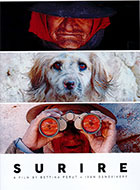
Surire 2015
Distributed by epf media, 324 S. Beverly Drive, PMB 437, Beverly Hills, CA 90212; 310-839-1500
Produced by Perut + Osnovikoff, Taskovski Films, Dirk Manthey Film
Directed by Bettina Perut and Iván Osnovikoff
DVD , color, 80 min., in Aymara or Spanish with English subtitles
High School - General Adult
Bolivia, Chile, Geography, Native Peoples
Date Entered: 01/06/2017
Reviewed by Cliff Glaviano, formerly with Bowling Green State University Libraries, Bowling Green, OHThe Surire Salt Flat is located in Chile near its border with Bolivia. It forms part of Lauca National Park, a UNESCO Biosphere Reserve. The high desert (10,000 to 14,000 feet above sea level) is home to hot springs, flamingos, rheas, chinchillas, and vicuñas. A few elders of the Aymara native people who lived in the Park before it was created continue to make a subsistence living in Surire by shepherding small herds of llamas. The stark beauty of the area is captured in Pedro Valdés’s cinematography. The vast area (28,000 acres) is quite remote and attracts only a few visitors.
The lifestyle of two elderly Aymaras is told by the camera, and by the landscape that dominates their surroundings. A large-scale borax mining operation using modern trucks and bulldozers about a mile from the couples’ ramshackle farm, contrasts starkly with their primitive assortment of run-down buildings. A few remaining habitable structures of stone and stucco, with thatched or corrugated metal roofs, serve as their living area. Fuel for heat and cooking consists of woody brush gathered daily. The borax operation is on the edge of the park and trucks appear to cross the border into Chile from Bolivia.
To tell the story of the Aymara, the filmmakers have the elderly couple plan a trip to an elders’ council in Putre, Chile, for New Year’s Day. A young Bolivian would shepherd their llamas while they were away. His wages were food, shelter, and an ancient bicycle. The couple set out on foot and hitched a ride with a borax truck to Putre where they were fed and housed at government expense for the elders’ council.
There are fewer than 2 million Aymaras living in the high country of the Andes with about 114,000 residing in Chile. Some, as the couple in this film, are living at the subsistence level. No religious rites or cultural practices are mentioned in this film, though the culture is strong overall and is described as a precursor to Inca culture. The poverty in which this couple lives is drastic. The bloody harvest of a young llama is graphic and potentially disturbing to some viewers. Still, Surire is highly recommended as a window on an indigenous people and a fine example of modern Chilean filmmaking. In depicting a culture that is known to be tied to the land, the filmmakers have allowed the beauty of the land itself to comment on its relationship with the Aymara. The film is in Aymara or Spanish with English subtitles. An excellent study guide is available for download from the distributor.
Awards
- Winner, Silver Nanuk for Original Artistic Solution, 2015 IDFF (Flahertiana International Documentary Film Festival), Russia
- Winner, Best Chilean Film, 2015 SANFIC (Santiago International Film Festival), Chile
- Winner, Fethi Kayaalp Grand Award for Best Film, 2015 BIFED (Bozcaada International Festival for Ecological Documentary), Turkey
- Winner, Best FILM, 2016 FECIPA Patagonian Film Festival, Chile